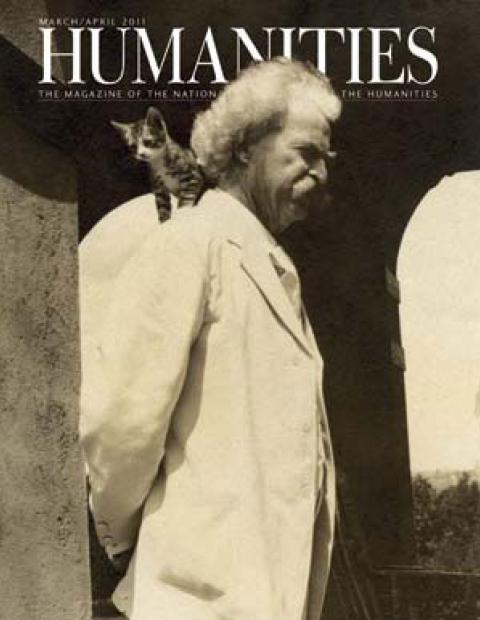Margret and Hans Rey tried to remain calm as the official came through the train car packed with refugees fleeing Nazi-occupied France and asked for identity papers. When the official saw the stacks of papers inside Hans’s bag, he became immediately suspicious. After all, the couple spoke with German accents. Could they be spies?
But when Hans Rey pulled out a manuscript for a children’s book entitled The Adventures of Fifi, about a mischievous and curious monkey who was always getting into trouble, the official smiled and passed them by.
Nearly a year later, after a harrowing wartime escape and journey to the United States, the couple would become known as Margret and H.A. Rey, and the monkey would be renamed Curious George.
The suspenseful tale of how the Reys—German Jews who had been living and working in Paris when the Germans invaded in 1940—escaped from Europe and made their way to the United States was the subject of an exhibit this winter at the Rey Center in Waterville Valley, New Hampshire, funded by the New Hampshire Humanities Council. The exhibit now heads to Naples, Florida, and then travels to Wichita, Kansas.
The source of the exhibition is a 2005 children’s book by Louise Borden and illustrated by Allan Drummond entitled The Journey That Saved Curious George: The True Wartime Escape of Margret and H. A. Rey.
Borden, a children’s book author with a particular interest in World War II history, says she knew nothing about the Reys’ dramatic wartime escape until she read a brief mention of it in Publishers Weekly. That led her to the Reys’ papers at the de Grummond Collection of Children’s Literature at the University of Southern Mississippi.
Lining the walls of a large room in the Rey Center’s gallery in Waterville Valley are items from the collection: a series of photos of the Reys and reproductions of Hans’s diaries and sketches, along with framed prints of Drummond’s artwork for the book.
The couple’s extraordinary story begins in Rio de Janeiro, where Hans Reyersbach, a budding artist who served in the German army in WWI, had gone seeking adventure. Margarete Waldstein, who, like her future husband, had grown up in Hamburg, made her own way to Brazil after Hitler’s rise to power. The two were married not long after she arrived and began working together on children’s books. In 1936, they took a honeymoon trip to France, where they stayed for the next four years.
The Reys were living in Paris when World War II began on September 1, 1939. As news of the Nazis’ advance through Belgium and Holland reached Paris, the Reys began to accept that, as German Jews, they were in danger and would have to leave their adopted country. They were able to secure updated Brazilian passports and collect what they would need for the trip. The exhibit displays pages from Hans’s diary as he meticulously recorded purchases the couple made in preparation. Finally, on two bicycles that Hans had built from one tandem bicycle and used parts, they set off for Spain and, then, Portugal, where they would be able to get a boat to Brazil.
The exhibit highlights Drummond’s energetic, whimsical illustrations of the Reys preparing for their escape and then leaving in a flood of refugees. Text aimed at young readers encourages the viewer to focus on how Drummond draws the eye with line and color and scale. It’s a nice touch in an exhibit that is, after all, about a prolific and talented illustrator.
The Reys boarded a train for Spain in Orleans, France on June 14, 1940, the day the Nazis marched into Paris. On June 23, they arrived in Lisbon. Three months later, after a stay in Rio de Janeiro to secure visas, the Reys arrived in New York. They would live the rest of their lives in their adopted country. The exhibit, which was organized and curated by Beth Seldin Dotan, the director of the Institute for Holocaust Education in Omaha, Nebraska, makes the point that the Reys were lucky to hold Brazilian passports, allowing them to emigrate and eventually to enter the United States, which had halted most immigration from Europe.
The Reys moved to Cambridge, Massachusetts, in 1963, and built a summer home in Waterville Valley. A series of lectures and programs sponsored by the Rey Center and the New Hampshire Humanities Council has put the Reys and their work in the larger context of American history and children’s literature, focusing on U.S. immigration policy, as well as the many children’s book authors who lived in Greenwich Village during the years the Reys lived there.
“The Wartime Escape: Margret and H. A. Rey’s Journey from France” has attracted a lot of national attention, says Audrey Eisenhauer, executive director of the Rey Center. “This has opened it up to the world,” says Louise Borden of the exhibit. “It has let people know about these perilous times and made them imagine a world without Curious George.”


